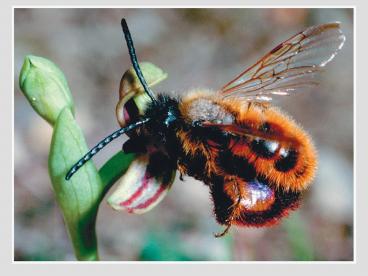Lecture 8 Outline (Ch. 38) PowerPoint PPT Presentation
1 / 34
Title: Lecture 8 Outline (Ch. 38)
1
(No Transcript)
2
Lecture 8 Outline (Ch. 38)
- I. Flower Structures
- II. Life Cycle
- Gametophyte Production
- Flower Development
- Pollination
- Fertilization
- Germination
- Preparation for next lecture
3
Angiosperm Overview
4
Angiosperm Lifecycle
5
Angiosperm Gametophytes
- Develop in anthers, ovaries
- Pollen from microspores inside the anther
- Within an ovule, a haploid megaspore divides by
mitosis - forms the embryo sac, the female
gametophyte
6
The megaspores give rise to
- pollen
- petals
- egg cells
- seeds
- ovaries
7
Model for Flowering (actually, end of ch. 35 in
this text)
- Flowering adult meristem becoming a floral
meristem - Activate or repress floral meristem identity
genes - 2 key genes LFY and AP1
- Turn on floral organ identity genes
- These define the four concentric whorls
- Sepal, petal, stamen, and carpel
8
ABC Model
- 3 classes of floral organ identity genes specify
4 organ types - Class A genes alone Sepals
- Class A and B genes together Petals
- Class B and C genes together Stamens
- Class C genes alone Carpels
- When any one class is missing, aberrant floral
organs occur in predictable positions
9
ABC Model
10
ABC Model
11
Based on the ABC model for flower development, if
A class genes are missing, what develops?
- sepal, sepal, stamen, carpel
- petal, petal, stamen, carpel
- stamen, petal, petal, stamen
- carpel, stamen, stamen, carpel
12
(No Transcript)
13
Angiosperm Pollination
- brings female and male gametophytes together
- Fertilization (syngamy) is preceded by
pollination, the placing of pollen on the stigma
of the carpel
One of my favorite pollinator systems
http//www.youtube.com/watch?v-h8I3cqpgnA
14
Abiotic Pollination by Wind
Hazel staminate flowers (stamens only)
Hazel carpellate flower (carpels only)
15
Pollination by Bees
Common dandelion under normal light
Common dandelion under ultraviolet light
16
Pollination by Moths and Butterflies
Anther
Stigma
Moth on yucca flower
17
Pollination by Flies
Fly egg
Blowfly on carrion flower
18
Pollination by Birds
Hummingbird drinking nectar of poro flower
19
Pollination by Bats
Long-nosed bat feeding on cactus flower at night
20
Angiosperm Pollination ? Fertilization
- The pollen grain produces a pollen tube that
extends down the style toward the embryo sac - Two sperm are released and effect a double
fertilization, resulting in a diploid zygote and
a triploid (3n) endosperm
21
Double Fertilization
One sperm fuses with the egg diploid
(zygote) One sperm fuses with the two polar
nuclei triploid (endosperm)
22
Angiosperm Seed Formation
- develops into a seed containing a sporophyte
embryo and a supply of nutrients - The zygote gives rise to an embryo with apical
meristems and one or two cotyledons - Mitosis of the triploid (3n) endosperm gives rise
to a multicellular, nutrient-rich mass that feeds
the developing embryo and later (in some plants)
the young seedling
23
Double fertilization refers to
- Two sperm fuse with the egg cell
- Two sperm fuse with the polar nuclei
- One sperm fuses with the egg, one with the polar
nuclei - One sperm fuses with the endosperm, one with the
tube cell
24
Angiosperm Seed Formation
25
The Ovary ...
- develops into a fruit adapted for seed dispersal
- a fruit is a mature ovary that protects the
enclosed seeds and aids in their dispersal via
wind, water, or animals
26
Dispersal by Water
Coconut
27
Dispersal by Wind
Winged seed of Asian climbing gourd
Dandelion parachute
Winged fruit of maple
Tumbleweed
28
(No Transcript)
29
The Mature Seed
- The embryo and its food supply enclosed by a
hard, protective seed coat - The seed enters a state of dormancy
- In dicots, the embryo has two cotyledons (seed
leaves) - A monocot embryo has one cotyledon
30
Evolutionary Adaptations ...
- the process of germination increases the
probability that seedlings will survive - Germination begins when seeds imbibe water
- this expands the seed, rupturing its coat, and
triggers metabolic changes that cause the embryo
to resume growth - The embryonic root, or radicle, is the first
structure to emerge from the germinating seed - Next, the embryonic shoot breaks through the soil
surface
31
Seed Germination (bean)
(a) Common garden bean
Foliage leaves
Cotyledon
Epicotyl
Hypocotyl
Cotyledon
Cotyledon
Hypocotyl
Hypocotyl
Radicle
Seed coat
32
Vegetative Reproduction Agriculture
- Humans have devised methods for asexual
propagation - Cuttings can be taken from many kinds of plants
- Grafting is a modification of vegetative
reproduction from cuttings - A twig or bud from one plant can be grafted onto
a plant of a closely related species or a
different variety of the same species
33
Self-Check
Part of plant Function Later becomes Examples
Ovary Contains eggs (ovules) Flesh of fruit Apples, strawberries, coconut meat
Pollen
Ovule
Integuments
Cotyledons
Endosperm
34
Things To Do After Lecture 7
- Reading and Preparation
- Re-read todays lecture, highlight all vocabulary
you do not understand, and look up terms. - Ch. 38 Self-Quiz 1-4 (correct answers in back
of book) - Read chapter 38, focus on material covered in
lecture (terms, concepts, and figures!) - Skim next lecture.
- HOMEWORK (NOT COLLECTED but things to think
about for studying) - Compare and contrast methods of pollination and
methods of seed dispersal used by angiosperms. - Explain the difference between pollination and
fertilization. - Diagram the parts of an idealized flower with
labels. - Describe the ABC model of flower development.

